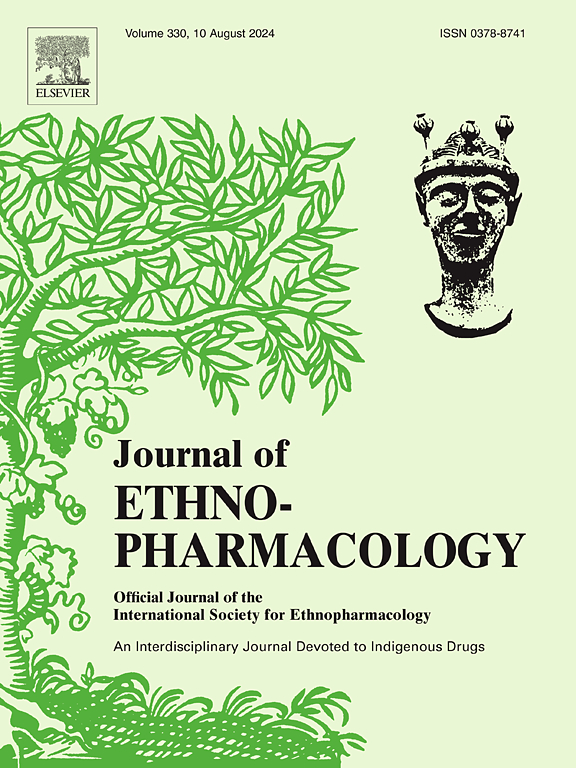Ferulic acid in Chaihu Shugan San modulates depression-like behavior, endothelial and gastrointestinal dysfunction in rats via the Ghrl-Edn1/Mecp2/P-mTOR/VEGFA pathway: A multi-omics study
IF 4.8
2区 医学
Q1 CHEMISTRY, MEDICINAL
引用次数: 0
Abstract
Ethnopharmacological relevance
In a global context of escalating multimorbidity, characterized by the co-occurrence of major depressive disorder (MDD), endothelial dysfunction (ED), and gastrointestinal dysregulation (GD), the quest for effective treatments has become paramount. Central to these interconnected conditions is oxidative stress (OS), a pivotal factor that has been extensively studied yet remains inadequately addressed. This study introduces Chaihu-Shugan-San (CSS) and its absorbed component ferulic acid (FA), a potent antioxidant derived from medicinal plants, as a novel therapeutic approach with the unique ability to counter the multifaceted effects of acute forced swimming (AFS)-induced depression, ED, and GD. Unlike traditional single-disease-focused studies, our research explores the synergistic effects of CSS and FA across these interrelated disorders, offering a groundbreaking perspective.
Aim of the study
This study aims to evaluate CSS and FA in treating depression-related multimorbidity triggered by AFS and to uncover the shared underlying mechanisms of FA.
Materials and methods
A depression-like model in rats was induced by AFS, and an OS model was established in endothelial cells (ECs) through hydrogen peroxide treatment. We investigated the effects of CSS and FA on MDD, ED, and GD in rats and OS levels in ECs. Our assessments included hematoxylin and eosin (HE) staining, biochemical assays, and behavioral studies. We conducted an integrated analysis of transcriptomics, proteomics, and phosphoproteomics data to elucidate the underlying mechanisms. The identification of relevant targets was confirmed through Western blotting (WB), real-time quantitative polymerase chain reaction (RT-qPCR), molecular docking studies, and an extensive literature review.
Results
Our findings indicate that CSS and FA not only significantly mitigate AFS-induced abnormalities in the open field test (OFT), forced swim test (FST), and related behaviors such as gastric emptying and intestinal transit in rats but also ameliorate depression, ED, GD, inflammation and OS-related biomarker levels, alongside HE staining in gastric sinus and aorta slices. The study also highlights that FA can influence OS and endothelial function in ECs. Moreover, a combined multi-omics analysis unveiled several OS-related pathways, including the mTOR and p53 signaling pathways. Our research elucidates that the Ghrl-Edn1/Mecp2/P-mTOR/Vegfa-associated OS signaling pathway is pivotal in countering AFS-induced multimorbidity, expanding beyond the conventional disease-specific focus.
Conclusions
This pioneering study underscores capability of CSS and FA to tackle AFS-induced multimorbidity concurrently and intricately details FA's antioxidative mechanisms within ECs. The insights gleaned offer a novel perspective on FA's role in multimorbidity regulation and its potential to modulate OS, especially in the complex environment of ECs. Given the urgent global health challenges, our research positions FA as a promising therapeutic contender, advocating for a paradigm shift in multimorbidity management.

求助全文
约1分钟内获得全文
求助全文
来源期刊

Journal of ethnopharmacology
医学-全科医学与补充医学
CiteScore
10.30
自引率
5.60%
发文量
967
审稿时长
77 days
期刊介绍:
The Journal of Ethnopharmacology is dedicated to the exchange of information and understandings about people''s use of plants, fungi, animals, microorganisms and minerals and their biological and pharmacological effects based on the principles established through international conventions. Early people confronted with illness and disease, discovered a wealth of useful therapeutic agents in the plant and animal kingdoms. The empirical knowledge of these medicinal substances and their toxic potential was passed on by oral tradition and sometimes recorded in herbals and other texts on materia medica. Many valuable drugs of today (e.g., atropine, ephedrine, tubocurarine, digoxin, reserpine) came into use through the study of indigenous remedies. Chemists continue to use plant-derived drugs (e.g., morphine, taxol, physostigmine, quinidine, emetine) as prototypes in their attempts to develop more effective and less toxic medicinals.
 求助内容:
求助内容: 应助结果提醒方式:
应助结果提醒方式:


